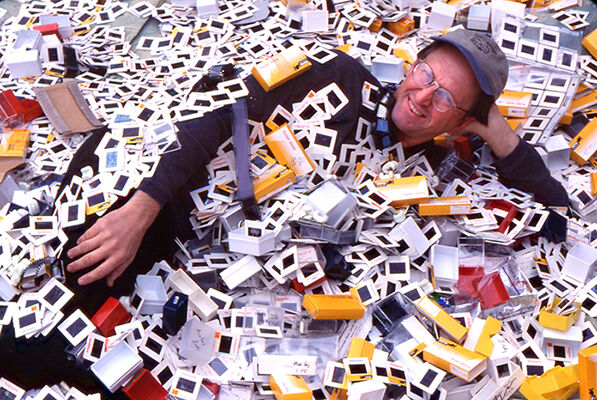About Bruce Hucko
Greetings!
I am a freelance photographer, author, art educator and radio producer whose primary work focuses on art, indigeneity and the environment. The landscape of the American West and the relationship people have with it figures largely in all of my work. Community and Communication are also primary themes. All of my work involves the continuum of human expression.
Another form of introduction might be - Born in Montana. Raised in Salt Lake City. No, I'm not.
My mother's people are from Montana via Kansas then Texas. They were part of one of the last big cattle drives from Texas and they stayed at the end of the trail. On her "Heinz 57" side I'm related to Dutch colonist Peter Stuyvesant and author Albert Payson Terhune. My father's people are from Czechoslovakia. Hucko is Slovakian with Polish undertones. (The original pronunciation is something like "hooch-caw" or "hooch-koh".) The meaning of the word is not exact but the word (hoo-chee) in the Slovak language means the sound made by running water or waterfall. This was so great to find out as I have an affinity for photographing water in the desert and I love to run the rapids of some of our western rivers. My father's parents fled the Russian invasion of 1908, were stowaways on a boat that came to America where they met and lived the rest of their lives in New Jersey. (Yep! I'm another Bruce from Jersey, right there with Springsteen and Willis!)
I graduated from the University of Utah with a BS in Business Management, former Eagle Scout, raised Lutheran, but .............
My photographic work is consistently published in national landscape related calendars and books. Fifteen books feature my work exclusively and I've contributed to more than a dozen others. My media credits include National Park Service slide shows for Arches National Park and Organ Pipe Cactus National Monument. I produced and was primary photographer for the 40-minute, 8-projector multi-media show The Canyon's Edge, produced for Canyonlands Field Institute in Moab with Tom Till and Terry Tempest Williams. It received a merit award from the Utah Humanities Council.
I divide my time between my own photography, publication projects, special projects, local community work and teaching art to children. For the latter I was recognized in 1984 by the Rockefeller Bros. Fund as one of 30 leading art educators in the United States and received a Rockefeller Bros. Fund Award for Excellence in Arts Education. This past year (2015), was named the Elementary Art Educator of the Year for Utah by the Utah Arts Education Association.
From 1978 until 1989, I lived on the Utah Strip of the Navajo Reservation where I served as classroom teacher and artist-in-education. That period began an involvement with Indian people that continues to this day. Premier among that work was the exhibit "Have You Ever Seen a Rainbow at Night? The Art Of Navajo Children." That work has been released in book form as A Rainbow at Night (44-pages, Chronicle Books, 1997).
After a decade among the Navajo I moved to New Mexico and worked with Pueblo communities. "Where There Is No Name For Art: The Art of Tewa Pueblo Children" (120 pages, School of American Research Press, 1997) is the result of that relationship. For that book, I received a 1998 Southwest Book Award and the 1997 Carey McWilliams Award given by Multicultural Review Magazine as "the best book of the year on the U.S. experience of cultural diversity."
I am the co-creator and co-coordinator of Voices of Youth, an audio/radio and photography project that trains youth in the art and craft of aesthetic documentary work. Using B&W photography and digital radio media, participants explore community-oriented subjects from a folklore or life-ways perspective. First created for the Western Folklife Center in Elko, NV, VOY-Moab produced from 2002-08 and received a 2006 UBEE Award from the Utah Broadcasters Association.
I love integrating with and learning from different media and art forms. I have done (or am doing) projects with poets, archaeologists, creative modern dancers, writers, sculptors, painters........... and children. Children and the land have been my primary inspiration for years and I truly see little or no line between by personal photography and teaching art. Children have taught me to play with the concepts followed stringently by others and to not take anything too seriously. From my literary friends I think of symbolism, metaphor and "getting the lines right." Dancers and the Navajo language have expanded my understanding of how to incorporate movement in a still frame. One of my favorite quotes (and I wish I could remember the artist's name!) is "A still life is still Life!"
My initial passion was for landscape photography. Since high school I wanted to have (and now have had) photographs published and sold by the National Parks. Moving to the Navajo Reservation in 1978 set free some thoughts on the relationship between people and place. They are forever entwined in my way of thinking, one influences the other, and I take as much pride and interest in my work with people as I do with the land.
While I engage in what is often called fine art and commercial photography, I tend to think of myself as a blue-collar photographer. I get the job done whether for a client or myself. I wake up thinking "Life! Great!" and sometimes find a way to express the joy of it through a photograph. At other times it's expressed by hiking, rafting or just washing dishes! The making of a photograph is like having a good conversation with a new or old lasting friend. Whether the subject is rock, tree or human, the process is the same. The photographer, subject, materials, equipment all contribute to create a mutually realized idea. I view photography as a life practice, a way of being. Active seeing is not something I turn on and do only when holding a camera; it's part of the art of living.

